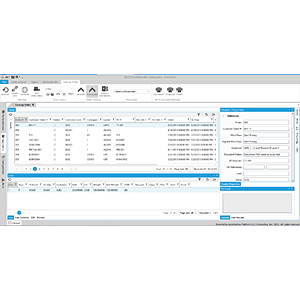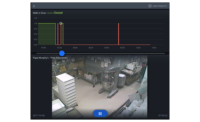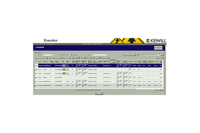Quality Refrigerated Services, Inc. upgraded its warehouse management software to Accellos’ cloud-based 3PL service, which in turn customized its services  and streamlined its billing practices. With several years of cold storage and meat industry experience under his belt, Tim Jackes helped execute Omaha, Neb.-based Millard Refrigerated Services’ expansion from only a couple of locations to more than 30 sites. Jackes worked part-time at a cold storage company while attending college. He worked full-time for another six years before joining Iowa Beef Processors (IBP), what is now Tyson Fresh Meats based in Dakota Dunes, S.D.
and streamlined its billing practices. With several years of cold storage and meat industry experience under his belt, Tim Jackes helped execute Omaha, Neb.-based Millard Refrigerated Services’ expansion from only a couple of locations to more than 30 sites. Jackes worked part-time at a cold storage company while attending college. He worked full-time for another six years before joining Iowa Beef Processors (IBP), what is now Tyson Fresh Meats based in Dakota Dunes, S.D.
When he decided to strike out on his own, Jackes had a modest vision; establishing Quality Refrigerated Services as a 3PL cold storage warehousing company that could excel in terms of the scope and flexibility of its services and customer accommodations.
Early in 2013, Jackes’ company ramped up that vision by upgrading its 3PL warehouse management software system from the hosted version of AccellosOne Enterprise 3PL, that had been in place for six years, to Accellos’ new 3PL software offering hosted in the Amazon Cloud.
“In the process, the company entered a trouble-free environment that has improved flexibility, security and productivity across the company,” says Michael Amundson, executive vice president.
Operations
Quality Refrigerated Services currently operates three facilities, with some 80% of its stored inventory represented by beef and pork. Its single-room, 1,325,000-cubic-foot freezer in Worthington, Minn., routinely inventories millions of pounds of fresh pork for its largest customer, JBS Swift, Greeley, Colo. A multi-room, 810,000-cubic-foot warehouse in Spencer, Iowa, supports both blast freezing and processing of fresh meat, also primarily pork.
The smallest location is a 474,000-cubic-foot, multi-room facility in Omaha, Neb., that ships millions of pounds of beef per week for local packers. The Omaha operations provide an array of custom processing and assembly services for numerous ranchers and local abattoirs that lack their own processing and cold storage facilities. Together, these accounts comprise a significant portion of the plant’s volume.
The facility also serves as the receiving and storage facility for many local packing houses and as a distribution center for a number of national companies. Its special services include kitting and other labor-intensive activities that larger local cold storage operators often find impractical.
“We try to give customers everything we can out of our unique facility, and that often involves services that don’t normally fi t the mold,” says Amundson. “We try to differentiate ourselves and at the same time fill a need in the market by offering our customers more choices and by enabling them with additional marketing opportunities.”
Not least of its specialized offerings is the company’s HACCP (Hazard Analysis Critical Control Point) plan service, which it provides customers to satisfy U.S. Department of Agriculture export requirements. Its export capability, which can provide door-to-door services for their international commerce initiatives, is a prized offering as well.
Technology migration
Given Quality Refrigerated Services’ relatively small size, the diversity of its facilities and its commitment to customized services, it has experienced its share of operations management technology challenges. Most of these challenges became much more manageable with the implementation of AccellosOne Enterprise 3PL software in 2007. Not inclined to establish an in-house computer center and maintain an IT staff, management opted for Accellos’ hosted software solution. In early 2013, it upgraded further to Accellos’ new managed services solution, which runs in the Amazon Elastic Compute Cloud, which satisfies all warehouse management solution technology levels at Quality Refrigerated Services’ facilities.
Quality Refrigerated Services’ technology migration began with a proprietary warehouse management software system.
“[It] did what was expected. It was simple and not very flexible,” says Amundson. “While our needs continued to grow, programming services were often questionable, so ultimately we had to reach out for a replacement system. Initially, the system was flexible and robust, and importantly, we could afford It. But, over time, serious challenges emerged in terms of both hardware and software. Frequent upgrades created incompatibilities that could involve new server requirements and software modifications as well as maintenance issues, all of which involved significant costs.”
Increasingly frustrated with the experience, management explored possibilities, and by 2007, narrowed its consideration to three alternatives, one of them being the AccellosOne Enterprise 3PL solution hosted at the Accellos data center.
Efficient, flexible, robust
“Accellos appeared to offer the best solution,” Amundson says. “It required very little from us in terms of systems and manpower. It provided a powerful software platform that could accommodate virtually any identifiable need. It also offered an opportunity to establish a much more flexible and efficient billing process—identifying and capturing charges is critical in the public warehousing business, and Accellos excelled in that area.”
“We found that we could do everything we tried to do with the system,” he adds. “The d’Amigo application allowed us to establish our own internal visibility parameters and generate a host of standard and proprietary reports that we could also share with customers. Additionally, for the first time, we were able to provide them with visibility to their own inventory through Accellos’ eVista web-based application, reducing the volume of our customer service tasks. We experienced no accuracy or integrity issues and we have been able to accommodate virtually any customer requirement.”
Clarity in the Amazon cloud
When online retail giant Amazon introduced its cloud service, Accellos explored the opportunity to transition its hosted clientele to the Amazon cloud environment. Satisfied that the cloud could provide a vigorous and secure operating environment for its hosted clientele, the company then offered its 3PL management software as a cloud-based system to new and existing customers in early 2012.
Key elements of the cloud offering include:
? Flexible subscription pricing
? Elastic computing resources
? Robust, flexible system
? No on-site IT presence
? High availability via multiple cloud sites
? “Elastic” computing resources
? Streamlined inventory management
? Accelerated kitting processes
? Flexible inventory analysis
? Flexible reporting via d’Amigo utility
? Online inventory status via eVista
? Customizable billing options
? More precise financial controls
? Increased revenues
? System and database administration services that ensure a healthy and stable system
? High-availability data center provides redundant power, internet and automated system monitoring that proactively identifies issues before they impact operations
? The ability to personalize the system to meet the needs of 3PL operators
Quality Refrigerated acquired the cloud solution in January 2013, and the entire upgrade was accomplished within three weeks. As before, the solution serves as the management platform for all warehouse-related operations, notably receiving/storage/shipping, packaging, kitting and documentation support.
“The AccellosOne Enterprise 3PL Cloud solution satisfies our needs very well,” Amundson says. “It provides enterprise-class technology that can be scaled quickly and easily to our needs. In our previous implementation, we had missed a couple of upgrades, so we obtained the most recent version of the software as part of the transition. Now, in many months of use, we have experienced no issues. Moreover, the cloud solution minimizes our involvement with the software since it is maintained and continues to be upgraded automatically by Accellos as the software continues to evolve.”
The only modifications required were in inventory management, where the physical counting process was accelerated and simplified, and in light manufacturing processes, where the software enabled a number of steps to be automated.
In the kitting process, for example, the software creates the kits and reduces the inventory count automatically as ingredients are drawn down and transferred to the kitting line. Too, lots can now be metered automatically, whereas before, the process was entirely manual and paper-based.
Receiving/storage strategies
According to Amundson, many of Quality Refrigerated’s customers are not always able to provide paperwork with their inbound shipments. Largely because there is often a lack of consistency in the records that accompany inbound loads, all three plants employ blind receiving. Warehouse personnel record everything that comes off the trucks and check the shipment paperwork against their actual counts.
All of Quality Refrigerated’s facilities were mapped out by aisles, rows and shelf positions several years ago when the Accellos-hosted solution was implemented, but how the warehouses operate within their individual geographies differs in the degree to which automation has been enabled in each one. Workflow varies from plant to plant, with the Worthington facility leading the others in the implementation and use of the Accellos system’s capabilities. The Worthington unit features nine aisles and serves a primary client. It is the only one in which radio frequency technology is utilized. Warehouse personnel are equipped with handheld RF devices to facilitate receiving, put-away, internal product transfers and picking and shipping.
At the facility, inbound product arrives fresh from packers. On arrival, the pallets are license-plated, scanned and sent directly to blast freezing. Out of blast freezing, the pallets are located optimally within the building according to their contents and temperature requirements. Temperatures across the sectors and aisles can vary, with some more severe than others. Location data is transmitted wirelessly to the Accellos software as the product is put in place.
The Spencer and Omaha plants perform most of the same warehousing functions as the Worthington plant and while similarly mapped, continue to operate using paper documentation. Whereas Worthington’s data enters the Accellos system automatically, the paper records at the smaller plants are relayed to the office staff, which inputs the data manually to the software.
A storage location might be recorded, for example, as “J” for the lot number “17” for the aisle location, and “B” for the rack level. These designations correspond generally to their more automated counterparts in Worthington, and when it’s time to pick and ship the contents, workers simply refer to their computer-generated paper pick orders to locate and pick the products.
Picking, processing, shipping
“The size and relative simplicity of the Spencer and Omaha locations makes paper processes feasible, if somewhat less streamlined,” Amundson says. “Nevertheless, the software has allowed us to improve operations appreciably. Put-away is not directed, but utilizes space that is available and noted on the paper slips that are forwarded to the office for entry into the Accellos software. Thus, the storage location of each unit of an inbound shipment is easily available from Accellos, which supports picking by printing out the necessary instructions so that whether for shipping, kitting or inventory transfer, the processes can be performed efficiently.”
“In Spencer, for example, product arrives as combination pallets,” Amundson adds. “Prior to entering inventory, the pallets are broken down and the contents counted and recorded manually as boxes of beef or pork sections received rather than as combo pallets. We don’t use pick lines at the Spencer and Omaha plants; rather, the SKU counts are normally small enough that we can pick and store by zone. If we receive a shipment of 200 SKUs, it is easy to break them down by product line and set them up in a logical picking sequence.”
Certain operations, notably kitting and inventory management, have been measurably accelerated and improved with the Accellos software. To assemble individual frozen sandwiches in meal kits, for example, the software creates the kit from a list of ingredients and orders the necessary elements out of inventory or, in some cases, from an outside source. The software’s inventory management feature receives the inbound ingredients into inventory for subsequent transfer to the production area. As the ingredients are drawn down for production, the software reduces their inventory counts and applies the appropriate charges to the respective owners. On completion of the production run, the kits either ship immediately or enter inventory under their new identity.
Results
“When Quality Refrigerated Services transitioned to the Accellos-hosted solution, it immediately realized several advantages,” Amundson says. “Probably the biggest advantage was that we had no extra software to deal with. On the management side, everything was good – anything we tried to do we were able to do. We had excellent customer product visibility, there were no accuracy or integrity issues and we could accommodate just about any requirement our customers might request.”
The recent migration to the Amazon Cloud platform also enhanced corporate comfort—the 3PL software was upgraded to Accellos’ latest version as part of the switch, and it will continue to be upgraded automatically as new versions are introduced.
“Normally, transitions kill you,” Amundson says, “but this migration was seamless. There is far more functionality that we are able to apply at this time, but we now have an abundance of choices, particularly in the area of reports and query response. We can flip, sort, analyze and email information automatically. There are more ways to customize our services, which makes it easier to generate revenue, since we can customize billing procedures to any customer situation or requirement—monthly, semi-monthly and even by the day.”
Inventory analysis is now available at a deeper level and the company is able to manipulate its data to generate a wealth of basic and custom documents with relative ease through the d’Amigo utility. The eVista online utility allows both the company and its customers to view customer inventory status at will, but it does not yet allow customers to enter their own orders.
“We had to make no major changes to accommodate the cloud upgrade, and that’s what we want,” says Amundson. “We don’t want to be involved with the information technology, and the cloud environment makes it totally unnecessary. We rely on the system 100%. We’ve had no outages. The system just works. We would be hard pressed to roll back the clock.”



